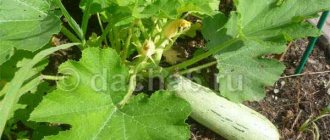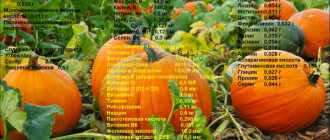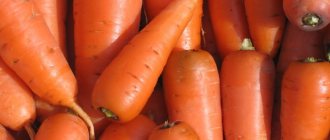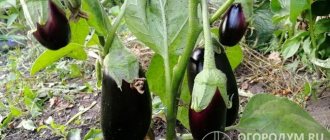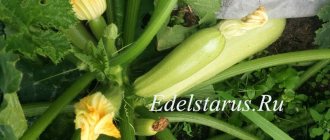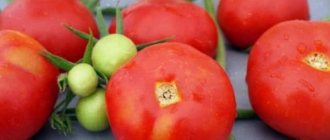Growing eggplants in Siberia – a few decades ago this idea seemed impossible. However, for many years in a row, gardeners in cold regions have been successfully harvesting these fresh nightshades. What varieties do Siberian summer residents love?
Eggplants are considered to be a heat-loving crop, which evokes associations with heat, southern sun and fertile soil. However, since the second half of the last century, “little blue” ones have been successfully grown in the middle zone and Siberia. Since these plants have a very long growing season (120-180 days), in the conditions of the short Siberian summer, preference should be given to early and mid-early varieties. In this article, we tried to select the most productive, reliable and hardy varieties of delicious eggplants for Siberia.
White Night
An early ripening variety for open ground and film shelters. The plant is quite compact, 60-75 cm high. The fruits are white, elongated pear-shaped, up to 25 cm long. They retain their presentation well for a long time. Flesh without bitterness. Excellent taste makes it possible to use eggplants for canning, pickling and other types of culinary processing. The variety is resistant to tobacco and cucumber mosaic viruses and is rarely affected by other eggplant diseases.
| Purpose | Productivity (kg/sq.m) | Fruit weight (g) | Maturation (days) | Flesh color |
| 5-7 | 200-300 | 105-115 | Snow White | |
When to plant seeds for seedlings?
Proper seed preparation is the key to future harvest
It is very important to decide when to sow seeds for seedlings. Seed preparation begins in early March or in the last days of February
To be sure of purchasing high-quality seed, purchase seeds in specialized stores and pay attention to the expiration date of the seeds
Next comes pre-sowing preparation. Let's consider the sequence of actions of a gardener to obtain a future harvest.
Seeds are checked for germination by placing them in a weak saline solution: 0.2 liters of warm water—1 teaspoon of salt. Empty seeds that do not sink to the bottom are discarded.
Seeds suitable for further processing are disinfected in a weak solution of manganese for 20 minutes.
Then the seeds are wrapped in a damp cloth and put in a warm place for 7-10 days.
Important! The napkin should remain damp throughout the entire germination period. To speed up the process of sprouting, add aloe juice, which is a biological growth stimulator.
Prepare the soil and containers for seedlings
A good soil mixture would be garden soil with the addition of humus, ash and peat in equal quantities. Eggplants do not like transplanting, so they use medium-sized seedling cups (300-400 ml) so that later the plant does not need to be picked.
Next, the seeds are sown in prepared soil, spilled the day before with a strong, hot solution of manganese. Sow 3-4 seeds per container to a depth of 2 cm. To create a favorable climate, cover with film until the first sprout appears. If several sprouts have sprouted in one glass, then leave the strongest one and remove the rest. Thus, the procedure of picking plants is avoided. If you still need picking, then take out an eggplant root with a lump of earth. It is convenient to do this with a tablespoon.
Before choosing a specific date for sowing seedlings, it would be a good idea to look at the lunar calendar of the gardener in the Siberian region to choose a favorable day for planting. “If you plant according to the moon, you will reap twice as much.”
Bibo F1
This hybrid variety is a true Siberian, as it is capable of setting fruit in extreme temperatures. Belongs to early ripening. The plant is semi-spreading, low. The fruits have a regular oval-conical shape, white with a grayish tint, without a glossy sheen. The pulp is not bitter and gives eggplants an excellent taste. Resistance to fusarium and tobacco mosaic virus has been recorded. And in other respects, the Bibo F1 variety is very hardy and healthy.
| Purpose | Productivity (kg/sq.m) | Fruit weight (g) | Maturation (days) | Flesh color |
| 4-6 | 300-400 | 95-105 | Whitish | |
Land preparation
How to grow eggplants correctly? After the optimal varieties for your region have been selected, it’s time to start preparing the substrate for further planting of seedlings.
First, decide on the container in which you are going to grow eggplants. This can be one large container or box, as well as small flower pots or disposable cups. If you sow the seeds separately, you will not have to resort to the process of picking the sprouts.
The direct mixing of all the necessary components to obtain the substrate deserves special attention. Take turf soil and mix it with sand, peat and humus. When the soil is ready to use, sprinkle it into your containers and pots and top it with a strong manganese solution. The best option is to purchase the substrate in a specialized store, but this will cost you a pretty penny.
If you did everything correctly, after two weeks the first shoots will appear in your containers. Do not try to dig up places where eggplant seeds are sown to check whether they are “alive”: such a procedure can disrupt the development process of the seed.
After sowing the seeds in the ground, do not forget to provide them with optimal conditions for growth. In particular, we are talking about the volume and frequency of watering. It is undesirable to oversaturate the soil with moisture, but you should not keep the substrate in drought either.
Bourgeois
An early-ripening, high-yielding variety that pleases both residents of the southern and northern regions with its fruits. The plant is powerful and large, semi-spreading, and has a long fruiting period. The fruits are very large (over 10 cm in diameter), dark purple with a slight gloss, more reminiscent of tomatoes than eggplants. The pulp is without bitterness and has an original taste. The bourgeois is not used to fighting diseases, so in order to grow healthy and large fruits, you will have to carefully study agricultural technology.
| Purpose | Productivity (kg/sq.m) | Fruit weight (g) | Maturation (days) | Flesh color |
| 4-6 | 400-500 | 105-110 | Greenish | |
Seed preparation
You can grow healthy seedlings only if you sow the seeds correctly. Before sowing seeds collected independently, they should be disinfected. To disinfect the seed, prepare a solution of hot water (100 ml, temperature 50 degrees) and hydrogen peroxide (3 ml), in which the seeds are soaked for 20 minutes and then washed in cool water. This procedure helps eliminate infections and strengthens the plant’s immunity. Seeds purchased in a store are treated against diseases and do not require additional disinfection procedures.
To obtain strong plants, the seed is kept for 24 hours in a solution of a growth stimulator (Epin, Baikal, sodium humate, etc.) diluted according to the instructions. Then they move on to the germination process. To do this, the seeds are moistened and placed in a container on a cloth. During the germination process, the temperature should not fall below 27 degrees, in addition, it is necessary to ensure that the tissue with the seeds is constantly moistened. After 1-2 weeks, the seeds begin to hatch. During this time, the soil should be prepared for sowing.
Helios
A mid-early variety with low (50-60 cm) stocky plants. The fruits are small, pear-shaped and cylindrical, purple-inky in color. The “sunny” name of the variety predetermined its unique mushroom taste. Proteins, carbohydrates, mineral salts and other beneficial substances in fruits are in a very balanced state, so they are used for therapeutic and dietary nutrition. The pulp is dense, without bitterness, with a sweetish taste. The variety is relatively resistant to various diseases.
| Purpose | Productivity (kg/sq.m) | Fruit weight (g) | Maturation (days) | Flesh color |
| 4,5-5,5 | 400-650 | 115-120 | Snow White | |
Clorinda F1
An early-ripening hybrid of eggplant, which is characterized by a powerful and tall plant (90-100 cm) with a pronounced stem and short branches. Eggplants of this variety can be grown on trellises and cables in a greenhouse and greenhouse. The fruits are oval, diamond-black in color with a glossy sheen. The pulp is dense, practically without seeds, in good presentation and without bitterness. The taste is classic, mushroom. The plant is very resistant to cold and tobacco mosaic virus.
| Purpose | Productivity (kg/sq.m) | Fruit weight (g) | Maturation (days) | Flesh color |
| 2,8-4 | 900-1 200 | 65-80 | Whitish | |
Maria
A high-yielding mid-season variety, the bushes of which can be grown in a greenhouse and under film cover in Siberian conditions. They grow to approximately 70-75 cm. The fruits are smooth and even, dark purple in color. The pulp is dense without bitterness, recommended for all types of culinary processing. Resistance to diseases (tobacco and cucumber mosaic) is quite high, as well as to frost and temperature changes.
| Purpose | Productivity (kg/sq.m) | Fruit weight (g) | Maturation (days) | Flesh color |
| 5-7 | 200-225 | 120-130 | White | |
What kind of eggplants grow in Siberia
The growing season for eggplants is long, but summer in Siberia is short. For the earliest ripening varieties, about 90–100 days pass from germination to the first harvest, for late-ripening varieties - up to 150. But the bush does not produce the entire harvest in one harvest, flowering lasts all summer until autumn, so the crop is grown even in the southern regions through seedlings and plant it in a greenhouse or greenhouse.
Eggplants in Siberia, as in all regions of Russia, are grown through seedlings
In Siberia, an average of 90 days pass from the last spring frost to the first autumn frost. This means that early varieties need to be grown in this region, and if there is a greenhouse, mid-season varieties.
Sailor
The fruits of this variety are difficult to confuse with any others. The striped lilac-white color clearly distinguishes them from their “brothers”. The plant is semi-standard, spreading, up to 75 cm high with a large number of oval-pear-shaped fruits. The pulp is without bitterness and is best suited for preparing caviar and other culinary dishes. These eggplants can be stored for quite a long time without losing their presentation. The variety was noted to be resistant to Verticillium wilt.
| Purpose | Productivity (kg/sq.m) | Fruit weight (g) | Maturation (days) | Flesh color |
| 8-10 | 250-400 | 100-105 | Snow White | |
Protecting plants from diseases and pests
Eggplants under unfavorable conditions can be susceptible to diseases and pests. The main ones:
- Blackleg. Occurs when there is excessive humidity. There is no treatment. The bushes are removed from the garden bed and the ground is disinfected.
- Late blight. With this disease, the leaf plates become covered with spots, the fruits are deformed. Fitosporin is used for prevention and treatment.
- Powdery mildew. The fungus attacks trunks, leaves, and fruits. The disease can be detected by a white coating on all above-ground parts of the crop. Fungicides are used to combat the fungus.
- Colorado beetle. The pest eats tender leaves, weakening the plants. It is collected manually or the plants are treated with insecticides.
- Aphid. The insect sucks cell sap from the leaf blades. Large colonies of aphids can destroy eggplants. Fitoverm, an infusion of ash, is used against the pest.
Important! Treatment with chemicals is stopped a month before harvesting the fruits.
Pelican F1
The neat bushes and fruits of this variety have gained popularity among Siberian gardeners. The plant reaches a height of 60-70 cm. The fruits are saber-shaped, milky white, matte in color. The pulp is medium dense, tender and tasty, without bitterness, suitable for all types of culinary processing. The variety is resistant to diseases. Its distinctive feature is the incredible beauty of bright violet flowers during the flowering period of the plant.
| Purpose | Productivity (kg/sq.m) | Fruit weight (g) | Maturation (days) | Flesh color |
| 2-3 | 180-200 | 115-120 | White with a yellowish tint | |
Harvest and storage
In Siberia, eggplant harvest begins in August. Their flesh becomes elastic by this period. Depending on the variety, the skin of ripe fruits acquires a white, purple, or lilac color. You need to harvest the crop on time, otherwise the pulp will become hard and bitter.
The fruits are cut with sharp pruning shears, with part of the stalk removed. They are wiped with a dry cloth and placed in a cool room. As a rule, eggplants are stored for 2-3 weeks. If you wrap them in paper, lay them out on straw, and cover them with thick material, the shelf life will increase by 1-2 months.
Ping Pong F1
This variety does not produce a very large harvest, but it has a number of other advantages. The bushes are semi-spreading, medium-leaved, 0.7-0.8 m high. The fruits are spherical, rather small (4-6 cm in diameter), during ripening they become white, with a slight gloss. The pulp is dense and gives the eggplant a piquant taste. The fruits are well stored and do not lose their consumer properties even after long-term storage. Plants are able to resist the main diseases of nightshade crops.
| Purpose | Productivity (kg/sq.m) | Fruit weight (g) | Maturation (days) | Flesh color |
| 1-1,5 | 60-80 | 110-115 | Greenish white | |
Black brilliant
An early ripening variety, the bushes are suitable for growing under film cover and in greenhouses. The plant is low (50-60 cm), semi-spreading. The fruits are large, cylindrical, with a black-violet tint and a bright glossy sheen. They tie at almost any temperature and in any weather conditions. The pulp is tasty, dense and without bitterness. When cooking, it is not necessary to soak vegetables in water. The variety's resistance to disease is average.
| Purpose | Productivity (kg/sq.m) | Fruit weight (g) | Maturation (days) | Flesh color |
| 5-6 | 200-250 | 105-110 | Milky white | |
Features of sowing seeds: step-by-step instructions
Growing eggplant seedlings is similar to sowing peppers and tomatoes. But there are certain subtleties, knowledge of which will help to grow strong seedlings (see video).
Seed selection
In the capricious Russian climate, it is recommended to grow hybrid forms that are unpretentious, resistant to diseases, pests, low temperatures, and high yields. But you cannot take seeds from them for subsequent sowings (like varietal eggplants), so you will have to spend money every year on buying seeds marked F1. The price of hybrids is higher, but the costs are fully recouped by good yields.
It is recommended to buy seeds from trusted manufacturers, pay attention to the description of the variety and features. Bags with hybrids often indicate that the seeds are processed, so they do not need soaking and germination
Containers: which ones are better?
The standard sowing scheme, when first common boxes are used, and then seedlings are planted in separate cups or pots, is not suitable for the crop
Eggplants do not tolerate transplantation well, they take a long time to get used to and straighten out. Therefore, the best way is to sow directly into separate glasses, pots, peat tablets
It is convenient to sow in small cassettes, and then pick up the bushes along with a lump of earth into larger containers. If there is not enough space, sowing in paper snails is used, and then the plants are planted in pots.
Good seedlings are obtained when grown in peat tablets. They are “washers” made of pressed peat and humus sealed in a non-woven casing. Growth stimulants and special antibacterial additives are also added to the composition. On one (upper) side there is a small hole where the eggplant seed is placed.
The tablets are placed at a short distance in a low tray and filled with warm water to swell. After some time they swell, increasing 2-3 times. The shell holds the shape of the “washers” and prevents them from falling apart.
Water the seedlings in tablets through a tray and drain off excess water. When the seedlings grow up, carefully remove the tablet shell, place it in cups along with the plant, and sprinkle with prepared soil. The roots are not injured during this picking, and the plant does not experience stress.
Preparing the soil
The culture prefers loose, fertile substrates with neutral acidity (pH 6.0-6.5).
Approximate composition of the soil mixture:
- garden soil (2 parts);
- humus (2 parts);
- peat (1 part);
- calcined river sand of coarse fraction (1 part);
- ash (liter per bucket of mixture).
Sand can be replaced with vermiculite, perlite, ash with crushed coals. Ready-made compositions are also suitable for sowing, but the composition must first be studied. Humus, vermiculite (river sand), ash, and turf soil are added to peat substrates.
Mixtures prepared by yourself are heated and disinfected (pink solution of potassium permanganate). To form beneficial microorganisms, it is advisable to use the addition of biological products (for example, “Baikal EM”).
Pre-sowing seed treatment
Hybrid seeds are sown directly into the ground. Seed material prepared independently, as well as varietal seeds, must be prepared for sowing.
Processing stages:
- warming up (dip the seeds into hot +45ºC water) for 4-5 minutes;
- disinfection in a pink solution of potassium permanganate (15 minutes). After the procedure, the seeds must be washed;
- soaking in any growth stimulant or microfertilizer solution. Epin, Zircon, Microvit are suitable;
- germination in damp tissue.
Some gardeners additionally harden eggplants before germination, keeping them for 4-6 days at night in the refrigerator at a temperature of +3ºC. During the day, the seeds are kept at +20ºC…+22ºC.
Sowing
After germination, the seeds are slightly dried and sown in prepared containers with soil. Sowing depth is up to 2 cm; before this, the substrate is slightly moistened.
For convenience, use tweezers, placing a seed in each hole. Cover the boxes or cups with film and keep them at a temperature of +25ºC…+28ºC. Usually sprouts appear after 5-8 days. As soon as thin shoots are visible, the shelter is removed, the containers with seedlings are placed in a bright place and the temperature is reduced to +18ºC.
Czech early
Early ripening high-yielding variety. The plant is stocky (50-60 cm), powerful and tall. The fruits are ovoid, shiny and smooth, dark purple in color. The pulp is dense, without bitterness. Suitable for all types of culinary processing and home cooking. The variety's resistance to diseases is average, as well as to temperature changes.
| Purpose | Productivity (kg/sq.m) | Fruit weight (g) | Maturation (days) | Flesh color |
| 4-5 | 300-500 | 100-110 | Greenish white | |
Nutcracker F1
This variety with a “fairytale” name belongs to the mid-early high-yielding hybrids. The bushes are spreading and quite tall - up to 80 cm. The fruits are oval, dark purple with a glossy skin. The pulp is not bitter; on the contrary, it has a pleasant mushroom flavor. The plant produces fruit regularly even in Siberian conditions. Eggplants are perfectly stored and can withstand long-term transportation. Seeds can be planted for seedlings in early March. The soil should be loose, light and retain moisture well.
| Purpose | Productivity (kg/sq.m) | Fruit weight (g) | Maturation (days) | Flesh color |
| 5-7 | 250-300 | 40-60 | White | |
So, as you can see, many varieties of eggplant can be successfully grown in Siberia. For the most part, these are hardy plants that are resistant to frost and temperature changes. Try planting them on your plot, and then you will be able to fully enjoy the magical taste of these “longevity vegetables,” as eggplants are called in Southeast Asian countries.
How to grow eggplants in Siberia
Eggplant is a very capricious plant; it requires a lot of light, heat, and timely watering. Even in a greenhouse, it is recommended to keep this crop alone, without neighbors, or to build a separate greenhouse to create a microclimate suitable only for eggplants. In addition, the most annoying and difficult to exterminate pests like to feast on the tender leaves of this southerner: the Colorado potato beetle, aphids, and spider mites. Prevention should begin during the seedling period.
Sowing seedlings
Early and mid-season eggplants produce buds approximately 60–70 days after germination. At this age, they need to be planted in the ground, since the flowers will fall off on the windowsill in conditions of cramped conditions, low light and ventilation.
The best planting time for early and mid-ripening varieties in Siberia is the first ten days of March. Seeds germinate in at least 10 days, shoots will appear in mid-March, and buds will appear in mid-to-late May. At this time, you can plant eggplants under temporary shelter - in a greenhouse made of arcs and film. If you sow later and plant in open ground in June, when frosts stop in Siberia, you will not get enough harvest. Before the onset of cold weather, only the first fruits will have time to ripen. For growing in a greenhouse, sowing is carried out earlier - in the second half of February.
Eggplant seeds take about 10 days to germinate.
Having decided on the timing, you can begin working with the seeds.
- Eggplants are small and inconvenient to soak, dry or sow wet, so sow them dry to a depth of 0.5–1 cm.
- Buy special soil for tomatoes, eggplants and peppers or universal soil for seedlings.
- Optimal temperature for eggplants: 22–28⁰C; at 15⁰C and below, the seeds will not germinate.
- Cover the box with the crops with glass or film.
- Open, ventilate and check soil moisture every day. If the top layer is dry, water or spray with water. Excess moisture is just as harmful as its lack.


